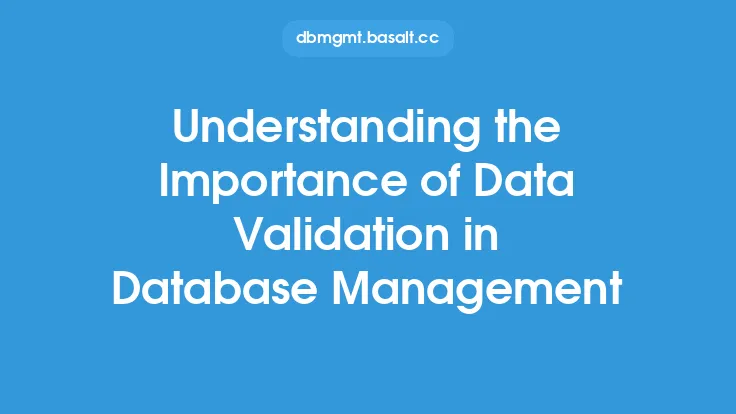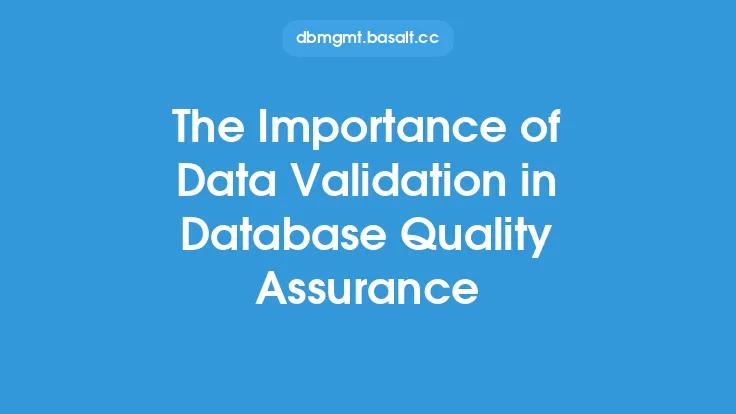Automated data validation is a crucial aspect of database management that ensures the accuracy, completeness, and consistency of data stored in a database. It involves the use of automated processes to check data for errors, inconsistencies, and invalid values, and to prevent incorrect data from being entered into the database. In this article, we will explore the benefits of automated data validation in database management, and how it can help organizations to improve the quality and reliability of their data.
Introduction to Automated Data Validation
Automated data validation is a process that uses algorithms and rules to check data for errors and inconsistencies. It can be performed at various stages of the data lifecycle, including data entry, data import, and data update. The goal of automated data validation is to ensure that data is accurate, complete, and consistent, and that it conforms to the rules and constraints defined in the database. Automated data validation can be performed using a variety of techniques, including data type checking, range checking, and format checking.
Benefits of Automated Data Validation
Automated data validation offers several benefits to organizations, including improved data quality, increased efficiency, and reduced costs. By automating the data validation process, organizations can ensure that data is accurate and consistent, and that errors are detected and corrected in a timely manner. Automated data validation can also help to reduce the risk of data corruption and data loss, and to improve the overall reliability of the database. Additionally, automated data validation can help organizations to comply with regulatory requirements and industry standards, and to improve their overall data governance.
Types of Automated Data Validation
There are several types of automated data validation, including syntax validation, semantic validation, and constraint validation. Syntax validation checks data for errors in formatting and syntax, such as invalid dates or phone numbers. Semantic validation checks data for errors in meaning and context, such as invalid values or inconsistent data. Constraint validation checks data against predefined rules and constraints, such as primary keys and foreign keys. Each type of validation has its own strengths and weaknesses, and organizations may use a combination of techniques to achieve their data validation goals.
Automated Data Validation Techniques
There are several automated data validation techniques that organizations can use to improve the quality and reliability of their data. These include data profiling, data quality metrics, and data validation rules. Data profiling involves analyzing data to identify patterns and trends, and to detect errors and inconsistencies. Data quality metrics involve measuring the quality of data using metrics such as accuracy, completeness, and consistency. Data validation rules involve defining rules and constraints to check data for errors and inconsistencies. Organizations can use a variety of tools and technologies to implement these techniques, including data validation software, data quality tools, and database management systems.
Implementing Automated Data Validation
Implementing automated data validation requires a thorough understanding of the organization's data and its business rules. Organizations should start by identifying the types of data that need to be validated, and the rules and constraints that need to be applied. They should then select a data validation tool or technology that meets their needs, and implement the tool or technology according to the manufacturer's instructions. Organizations should also test and refine their data validation processes to ensure that they are working correctly, and that they are detecting and correcting errors and inconsistencies.
Best Practices for Automated Data Validation
There are several best practices that organizations can follow to get the most out of automated data validation. These include defining clear data validation rules and constraints, testing and refining data validation processes, and monitoring and reporting data validation results. Organizations should also ensure that their data validation processes are scalable and flexible, and that they can handle large volumes of data. Additionally, organizations should ensure that their data validation processes are secure and auditable, and that they comply with regulatory requirements and industry standards.
Common Challenges and Limitations
Despite the benefits of automated data validation, there are several common challenges and limitations that organizations may encounter. These include the complexity of data validation rules and constraints, the need for ongoing maintenance and updates, and the potential for false positives and false negatives. Organizations may also encounter challenges in integrating automated data validation with other data management processes, such as data integration and data warehousing. To overcome these challenges, organizations should ensure that they have a thorough understanding of their data and its business rules, and that they have the necessary skills and resources to implement and maintain automated data validation processes.
Future of Automated Data Validation
The future of automated data validation is likely to be shaped by advances in technology and changes in regulatory requirements. Organizations can expect to see increased use of artificial intelligence and machine learning in automated data validation, as well as greater emphasis on real-time data validation and data quality metrics. Additionally, organizations can expect to see increased focus on data governance and data compliance, and greater emphasis on ensuring that automated data validation processes are secure and auditable. To stay ahead of the curve, organizations should ensure that they are keeping up with the latest trends and developments in automated data validation, and that they are investing in the necessary skills and resources to implement and maintain effective data validation processes.
Conclusion
Automated data validation is a critical aspect of database management that ensures the accuracy, completeness, and consistency of data. By automating the data validation process, organizations can improve the quality and reliability of their data, reduce the risk of data corruption and data loss, and improve their overall data governance. While there are several challenges and limitations to automated data validation, organizations can overcome these by ensuring that they have a thorough understanding of their data and its business rules, and that they have the necessary skills and resources to implement and maintain effective data validation processes. As technology continues to evolve and regulatory requirements continue to change, organizations can expect to see increased emphasis on automated data validation and data quality metrics, and greater focus on ensuring that data validation processes are secure and auditable.





